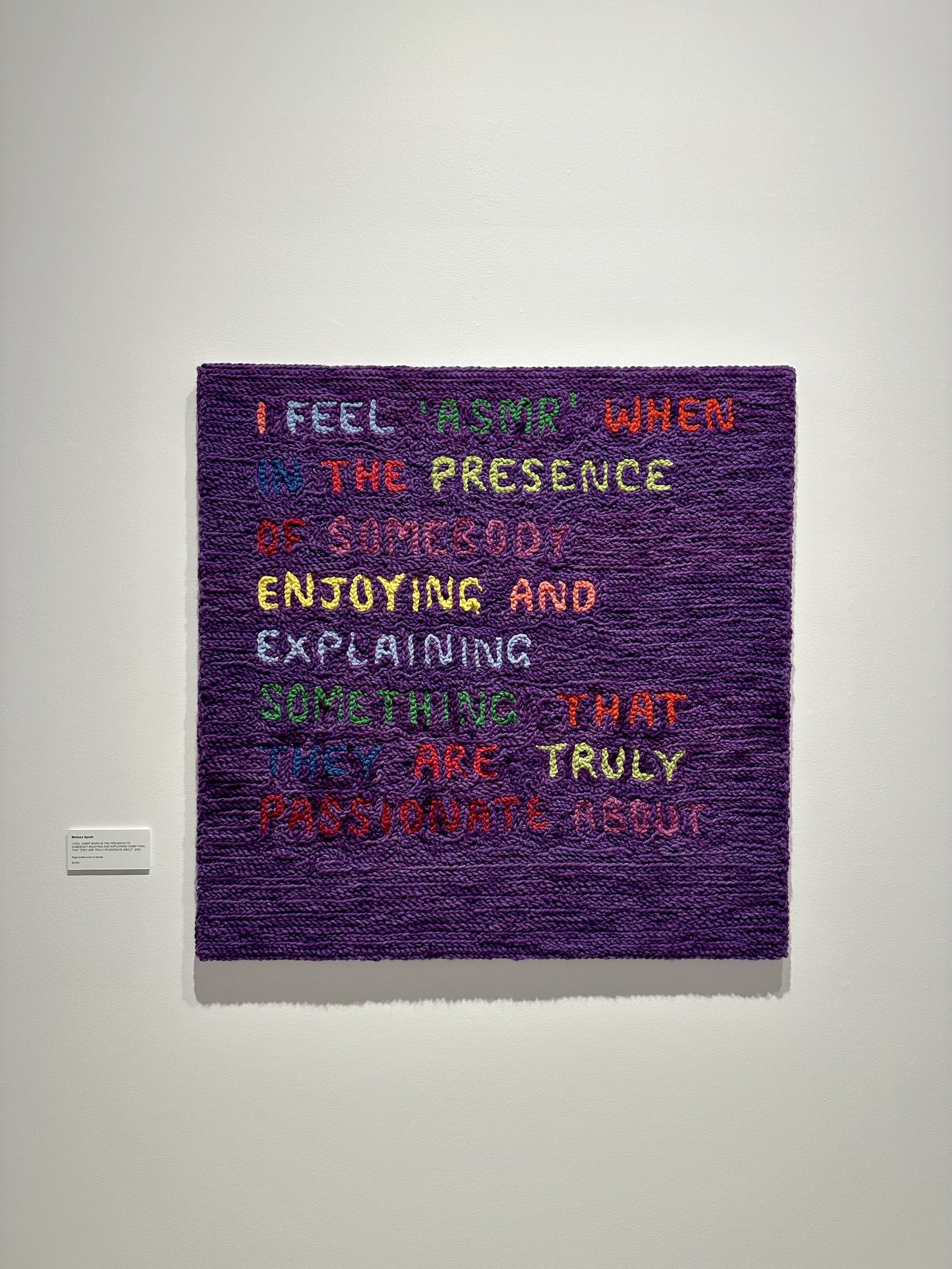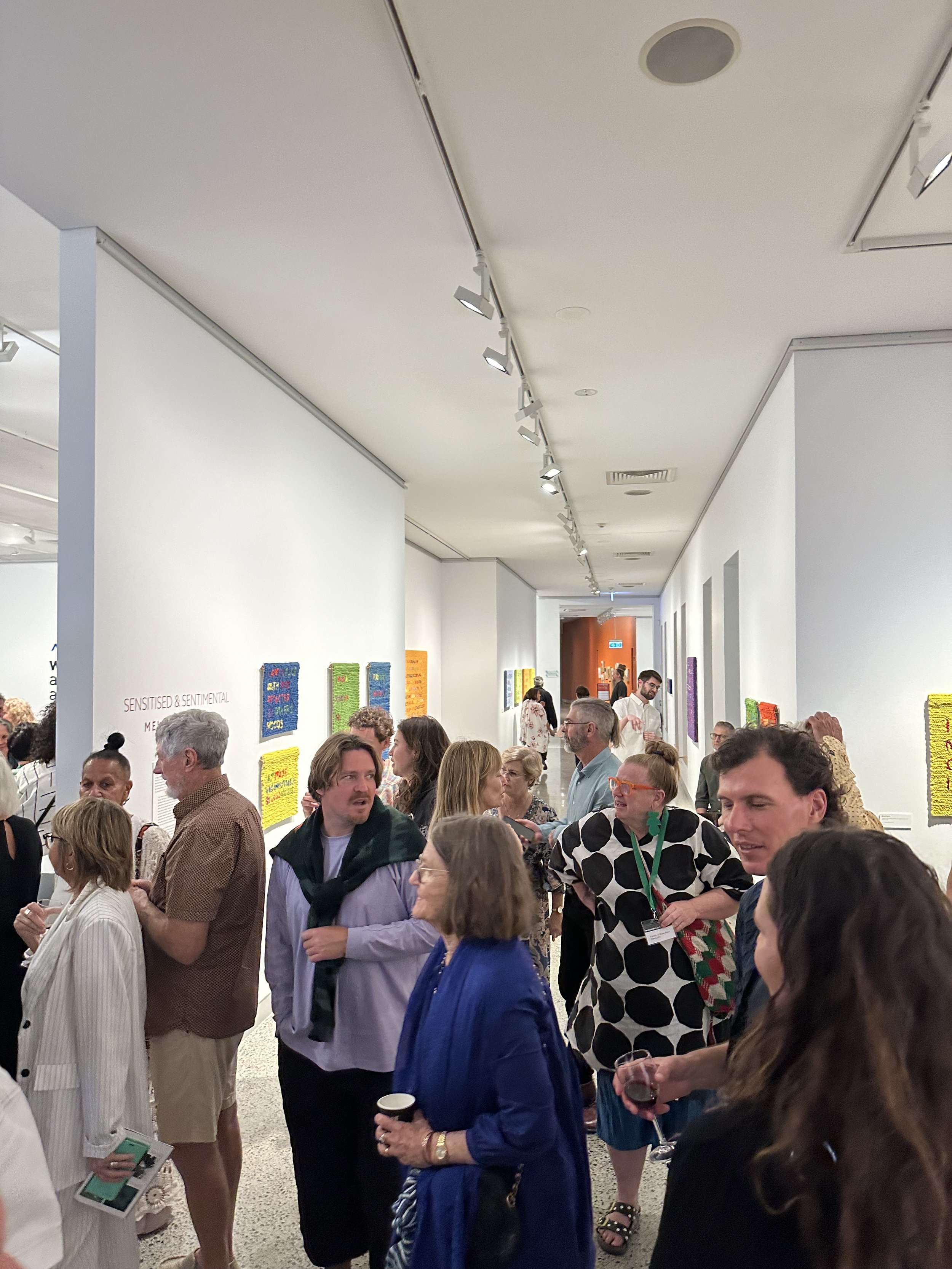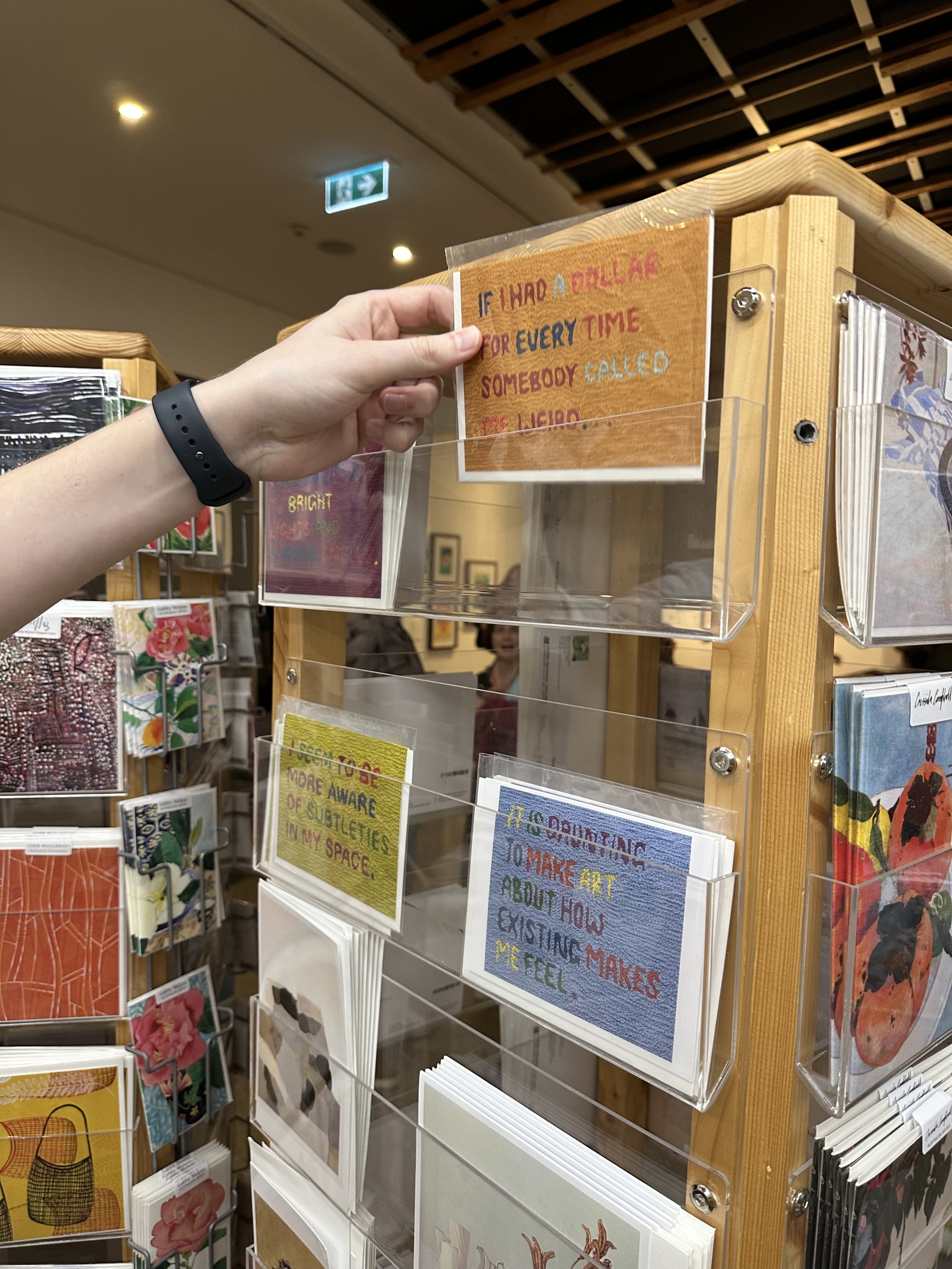Practice
“I am a very meticulous maker and each aspect of my work is created through subtle abstraction of, and interaction with, personal identity. My practice focuses on themes of becoming into belonging, interrogating the world around me as subject matter, and questioning. I seek answers to and hold curiosity for, self-identity and human perception. I describe my practice as a reflection of self, my most inner feelings and contemplations, a subconscious recount of my passions and vulnerabilities. I find influence and theoretical concerns in internal production processes, which are brought forward and highlighted through material choices. I am known for my finger knitting explorations with wire, yarn and fabric, where I am continually developing new work and expanding this technique. My work has a reliance on the tactile nature of human discovery, which I believe enables my process to reach creative and original outcomes.”
Recent Work
Melissa Spratt with her finger-knitted textile artwork ‘Stream of Consciousness’, 122 x 183cm, 2024
[Images: Claudio Kirac]
SENSITISED & SENTIMENTAL — Essay by Bree Di Mattina, 2024
Melissa Spratt is a Highly Sensitive Person. Not merely an observation of her personality, recognition of this tendency gave Spratt answers to questions she had always had about herself. Identified in 1996 by psychologist Elaine Aron, those who are Highly Sensitive experience extra-ordinary bodily and emotional responses to a variety of emotional and sensory stimuli. Varying between individuals, those affected can experience sensitivities to clothing, food, sounds, smells, crowds, music, artworks and many other occurrences which may prompt an emotional or sensory response. Over exposure to stimuli can lead to physical reactions, feelings of overwhelm, anxiety, panic attacks or depression. Often viewed in conjunction with sensitivity, sentimentality is the arousal of emotions, often linked to tenderness, sadness or nostalgia. The two concepts from which the title of this exhibition is drawn convey the emotion and honesty with which the works are created.
As an artist working with textiles and fibres, it would be easy to align Spratt’s practice with the ubiquity of comfort drawn from textiles. Materials with which we are all familiar, which accompany and bring us warmth and protection through life, used in art of a personal nature. Textiles are also linked to memory, with many provoking sentimental responses. Yet for many who are Highly Sensitive, textiles, clothing and textures may exacerbate rather than soothe their emotions and responses. Often these items are more a symbol of irritation than comfort.
Spratt’s choice of wool is somewhat of a paradox. Wool is a fibre with which many have a conflicted relationship, not only those who identify as Highly Sensitive. It is a fibre which can hold multiple properties: soft or rough, soothing or irritating, warming and cooling, delicate and strong. Like the multitude of stimuli which may affect Highly Sensitive People, wool also comes in a variety of forms, employed in a variety of situations. In Spratt’s work, the choice of wool, sourced from Bec Andersen, a local artisan dyer, designer and rug maker, elucidates the complex nature of being Highly Sensitive. The strong, somewhat coarse Romney-cross fleece from New Zealand is a robust product. The tactile, fibrous media is mobilised by Spratt, contrasting against the delicacy of her subject matter.
Rather than exploiting the connotations between textiles and comfort, Spratt instead uses the directness of text to convey the uncomfortableness of the Highly Sensitive.
Text and textiles are linked etymologically, sharing the Latin root ‘texere’ meaning ‘to weave’. In her SENSITISED & SENTIMENTAL works, Spratt weaves her experience as a Highly Sensitive Person into her practice. The bold letters spell out her innermost thoughts and feelings, using text to convey without ambiguity. Works range from short statements explaining what impacts her, to longer, stream of consciousness style pieces which convey the flood of thoughts and emotions she experiences. The works serve to both explain her situation, as well lending others space to contemplate their own responses to sensory and emotional stimuli.
Utilising the speciality wool, Spratt begins each work by making metres and metres of narrow, finger-knitted chain. Repetitive actions such as knitting are widely accepted as a tool for calming and it is from this soothing base that Spratt builds her works. Drawing the letters onto the canvas, Spratt arranges lengths of finger-knitting to form each word. Once the words are formed, she meticulously envelopes them with more lengths of finger-knitting, ensuring no gaps remain. Filled with colour and texture the works allow nowhere for the eye to rest.
The SENSITISED & SENTIMENTAL works are like tactile poems. Rather than opting for soothing, muted tones, Spratt instead uses high value colours. The pieces are vibrant and textured, yet the air of colourful fun does not diminish the seriousness of the underlying concepts. Laboriously spelling out her innermost thoughts, Spratt unites ideas within her statements by combining particular words and colours, making each sentence carry the burden of multiple thoughts. High value colours, combined with capitalisation of the words, make forthright statements about the artist’s feelings. She declines the softness of pastels and the playfulness of lower-case text, instead opting for unapologetically bold capitalisation. The resulting works are forthright without being overbearing. The use of wool softens the message, yet the obvious texture within the pieces reinforces the sensory nature of the subject matter.
Responses to sensory stimuli are highly subjective, with no two people experiencing stimuli in the same way. Spratt’s Sensitised & Sentimental works move beyond the tropes associating textiles with comfort, instead using text, colour and texture to unambiguously convey her experience. The complexity of wool as a material is exploited in conjunction with colour and form, resulting in nuanced works which capture the dynamic nature of the senses.
SENSITISED — Essay by Rebecca Ross, 2021
Responding to the work of Melissa Spratt
Immediacy and attunement to sensations are the primary evocations of Melissa Spratt's latest exhibition Sensitised. The exhibition encompasses ten artworks, accompanying film, photo documentary series and limited edition prints. Crafted whilst observing the havoc of a pandemic, and horrific natural disasters, the works in the exhibition reflect on our sensitivity to an ever-changing environment.
Through the artist's lens (and that of her film-making collaborators) Sensitised captures the artist's considered approach to the world and makes a space for us to consider our feelings, our environment, and our responses to its exhilarated state of flux. Sensitised ties together an array of worldly concerns, synthesising them into a body of work that despite its two dimensionality comes at you from all angles. The brightly coloured phrases, copied verbatim from a public source, are rendered in a handwritten fashion, delivering each phrase with a softness that draws you in and then pushes you to think beyond the wooly surfaces.
The core medium of the work is pure wool (from Romney Cross Breed Sheep) which the artist finger-knits to create something akin to a flocculent chain. This process is twofold in its form and function; the infinite loops and act of knitting allow the artist to both process the statements expressed in the work, and to create a cord that enables her to manipulate colour and texture into elaborate formations. Much like the statements that the work presents, the technique of finger-knitting creates something that is both strong - the weaving strengthens the yarn - and yet vulnerable, easily unravelling at the pull of an end.
The frenetic energy and flexibility of the finger-knitting is pinned down in the final iterations of the work, with the artist adhering each length of braid to a flexible substrate. The outcome manifests as a hybrid form of weaving, embroidery and appliqué, and artfully echoes the banners of the Suffrage Movement, which were made by women to express themselves in public protests. Similarly in Sensitised, personal statements (used to identify Highly Sensitive Persons) are given a voice in public space, in this case by being hung in a gallery and hosted on social media for the outer world to see.
The spaces that the works emerge from are those of the personal and the psychological. These entwined themes swirl around, much like the surface tensions in the works, their complex and concentric patterns contouring the edges, and s -p-e - I-I-i-n-g o-u-t each letter. The words are literally strung together, with each work interwoven with the next through spectral arrangements and sequential threads, and into a suite of text-based works that Melissa has been labouring over for the past 18 months.
This repetitive labour parallels women's work, and follows a line of enquiry that textile and fibre art bought to the fore through the Feminist Movement in the 1970's, and the 1980's when fibre-based art began to focus on cultural shifts, politics and the flexibility of the medium itself.
The lineage of the use of fibre-based techniques to convey meaning and to tell stories, can be traced back through millennia; from the woven fabrics of ancient Incan society where colour and pattern signified military ranks, to flemish tapestries telling allegories of mythical beasts, and Iranian carpets interwoven with tales told in abstract symbols and hand-dyed hues. Like these examples Melissa's works employ handwoven formations to communicate messages and meanings far beyond the immediate materiality of the work.
Mapped out in chromatic colours, the gathering of phrases in the exhibition are imbued with measured gestures and an overarching sense of vulnerability. The forthright statements embedded in monochromatic fields are softened by the sensitive approach of the artist and a tactility that beckons the viewer to reach out beyond the eye-line. Sensitised overarchingly prompts us to go deeper into our interior worlds, to attempt to reconcile our psyches with the events outside of ourselves, and the things outside of our control. There's an immediate sense of identifying with what is presented to us, and if not, of questioning...
What is it that I am sensing right now?
Art Documentary
... is a short documentary film about ten artworks crafted whilst observing the havoc of a pandemic, and horrific natural disasters. The work and the film reflects on our sensitivity to an ever-changing environment.
A film in collaboration by #Melissa Spratt, #Pablo Mejia-Lopez, #Salvador Cantellano.
Produced By #Salvador Cantellano with support from #Studio Luma #craftivisim #filmmaking #Documentary #shortfilm #HSP #artwork #fingerknitting #craft #CliamateChange
Credits
INTERVIEWEES
Melissa Spratt, Bec Anderson, Tristan Schultz, Melissa Spratt, Bec Barnett, Rebecca Ross.
POEM
"Sensory Processing Disorder” Written By Esther Ottaway and Read By Melissa Spratt
PRODUCTION CREW
Cinematography & Lighting By
Pablo Mejia-Lopez
Salvador Cantellano
Ryan Thistleton
Location Sound Recording
Kempsey Lion
Salvador Cantellano
Pablo Mejia-Lopez
POST PRODUCTION
Edited and Sound Design By
Pablo Mejia-Lopez
Salvador Cantellano
Colour Grade & Titles
Salvador Cantellano
ORIGINAL MUSIC
Licenced by Artlist.io
RIVER By Lane King
MYSA By Laurel Violet
BLANKET (Instrumental Version) By Lance Conrad
MIDNIGHT By Matooma
A PLACE BEYOND BELIEF By SLPSTRM
CLOSER By Ian Post
FEELING OK TODAY By Fair Game
BEAUTIFUL By Ben Potter
This project “Sensitised” is supported by the Queensland Government through Arts Queensland. The Regional Arts Development Fund is a partnership between the Queensland Government and City of Gold Coast to support local arts and culture in regional Queensland.
Technical Support By
Studio Luma. Bring Ideas To Light
Copyright 2021
Melissa Spratt, Pablo Mejia-Lopez, Salvador Cantellano.
Previous Work
HOTA GALLERY PODCAST SERIES
HOTA: Solid Gold Artists in Conversation.
I was invited to participate in a podcast series, which has been launched in accordance with the new 2021 Home of the Arts gallery opening on the Gold Coast.
YARN 2048 — This beautiful film spotlights artist Melissa Spratt and Relative Creative as they collaborate on a textile piece of protest art. The artwork is contemporary in nature while the film is nostalgic in style. The aim was to complement the nostalgia that yarn invokes while focusing on the process and philosophy behind the artwork of the futures map. A film by Salvador Cantellano Copyright Relative Creative For more information go to relativecreative.com.au
‘Essential Existence’ - Melissa Spratt @create_originate // Sound: Uke by @bill_durry // AIR - The Walls Art Space. Miami, Gold Coast. QLD. Australia.
Online Exhibition // Open Studio of my time at 11th Ave Creative as their March - April - May 2019, Artist in residence. Thanks to: Gold Coast City Libraries Sound: Buseka - @bill_durry
![Melissa Spratt with feature artwork at the Tweed Regional Gallery and Margaret Olley Art Centre, 2024 [Images: Claudio Kirac]](https://images.squarespace-cdn.com/content/v1/53f5a8b0e4b08ac546a20301/1732501391090-AK2LPP199JXHHBTSOITI/Melissa-Spratt_TWEED_Nov204_LR-05299.jpg)
















